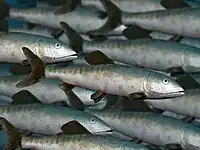Bananogmius
Bananogmius is an extinct genus of ray-finned fish that lived in what is today Kansas during the Late Cretaceous. It lived in the Western Interior Seaway, which split North America in two during the Late Cretaceous.[1][2] Some species like B. evolutus later reclassified as Pentanogmius.[3]
| Bananogmius Temporal range: Late Cretaceous | |
|---|---|
 | |
| Artist's impression of B. aratus | |
| Scientific classification | |
| Domain: | Eukaryota |
| Kingdom: | Animalia |
| Phylum: | Chordata |
| Class: | Actinopterygii |
| Order: | †Tselfatiiformes |
| Family: | †Plethodidae |
| Genus: | †Bananogmius Whitley, 1940 |
| Species | |
| |
Description
As with many plethodids, Bananogmius had a thin body reminiscent of the modern angelfish, dozens of small teeth, and an high dorsal fin.[4]
References
- Fielitz C, Shimada K. 1999. A new species of Bananogmius (Teleostei; Tselfatiformes) from the Upper Cretaceous Carlile Shale of western Kansas. Journal of Paleontology 73(3): 504-511.
- Taverne L. 2001. Révision du genre Bananogmius (Teleostei, Tselfatiiformes), poisson marin du Crétecé supérior d'Amérique du Nord et d'Europe. Geodiversitas 23(1):17-40.
- Taverna, L. (2000). "Ostéologie et position systématique du genre Plethodus et des nouveaux genres Dixonanogmius et Pentanogmius, poissons marins du Crétacé (Teleostei, Tselfatiiformes)". Biologisch Jaarboek Dodonaea. 67 (1): 94–123.
- Everhart, Mike (23 Aug 2011). "Plethodids". Oceans of Kansas. Retrieved 28 April 2014.
This article is issued from Wikipedia. The text is licensed under Creative Commons - Attribution - Sharealike. Additional terms may apply for the media files.






